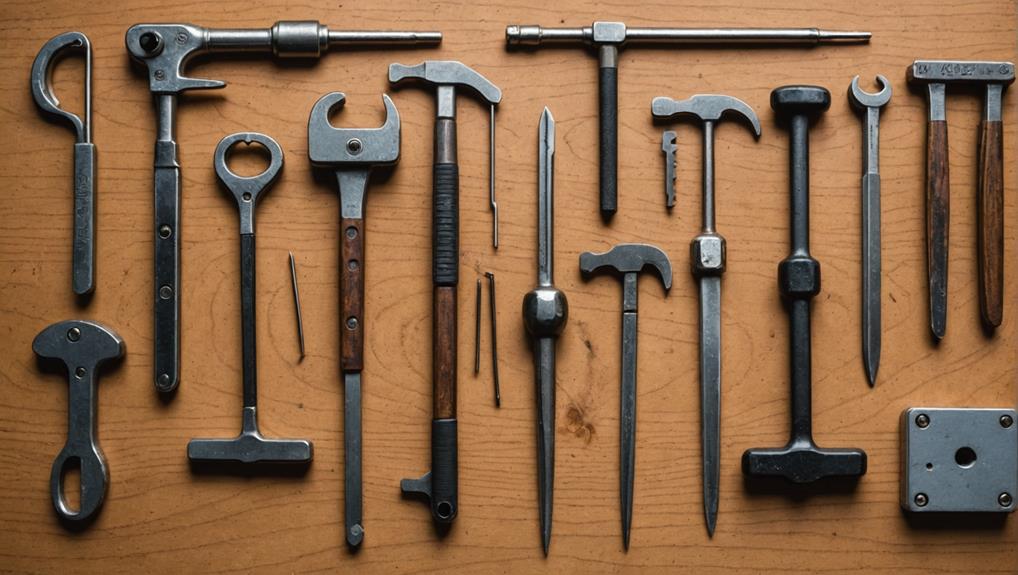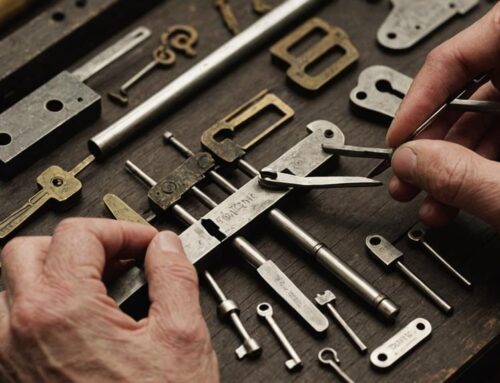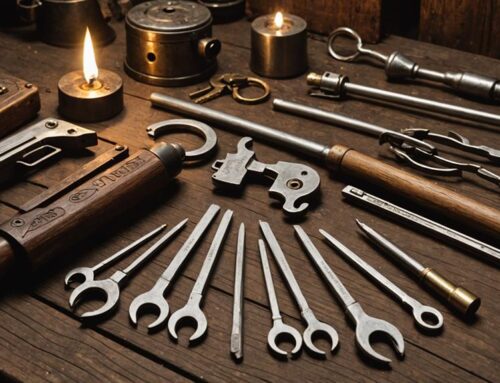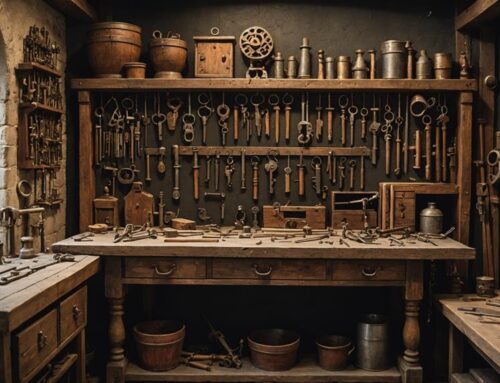Travel through time exploring the evolution of lock picking tools from ancient bone and metal instruments to today's digital marvels. Early locksmiths honed their craft with tools like the "hook pick" and "tension wrench," showcasing resourcefulness that laid the foundation for modern techniques. From Egyptian hieroglyphic inscriptions to medieval guild influences, each era introduced new complexities shaping locksmithing. The Industrial Revolution propelled mass production of intricate tools, revolutionizing the trade. Advancements like lever tumblers and pick guns improved speed and efficiency, setting the stage for modern techniques. Discover the secrets behind these tools' evolution and the impact of military advancements on locksmithing.
Key Takeaways
- Early locksmiths used bone and metal tools, evolving to specialized hook picks and tension wrenches.
- Egyptian locksmiths pioneered pin tumbler locks with intricate wooden picks.
- Guild regulations influenced tool development in response to complex lock mechanisms.
- Industrial Revolution enabled mass production of intricate lock picking tools.
- Modern advancements include electronic lock picks and automated machines for precision and speed.
Ancient Lock Picking Tools
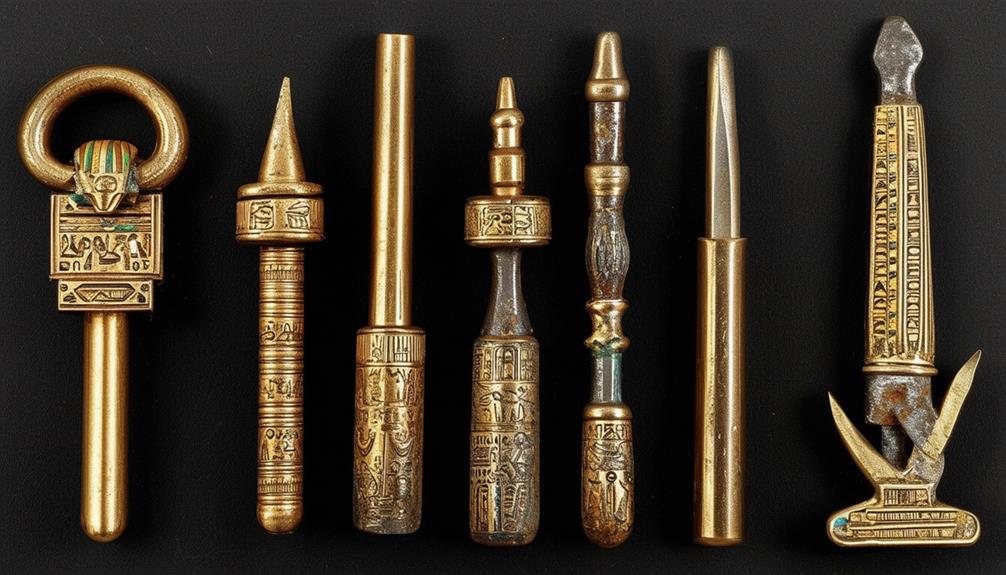
When exploring the history of lock picking tools, one can't overlook the ingenuity of ancient locksmiths. In ancient times, lock picking tools were rudimentary yet effective, often designed to interface with the basic mechanisms of locks that were prevalent at the time. Crafted from materials like bones, wood, and metal, these ancient tools were used to manipulate the mechanisms of simple locks.
One common tool was the "hook pick," a small, curved instrument that could lift individual pins within a lock to open it. The "tension wrench" was another essential tool, used to apply pressure to the lock cylinder while the pins were being manipulated. As documented in the history of lock picking techniques, ancient locksmiths developed their methods based on the functionality of these early locks.
Ancient locksmiths honed their skills through trial and error, developing techniques that are still used in modern lock picking. The process of using these ancient lock picking tools required patience, precision, and a deep understanding of how locks functioned.
Despite their simplicity, these tools were instrumental in securing valuable items and protecting important spaces in ancient societies.
As you explore the world of ancient lock picking tools, you'll appreciate the resourcefulness and craftsmanship of those early locksmiths who paved the way for the tools we use today.
Egyptian Innovations

Amidst the rich tapestry of ancient locksmithing history, Egyptian innovations stand out as remarkable contributions to the evolution of lock picking tools. The ancient Egyptians were pioneers in developing techniques and tools that revolutionized the art of locksmithing, including the early use of mechanisms that would influence later designs.
Here are some key innovations from ancient Egypt:
- Pin Tumblers: Egyptians were among the first to use pin tumbler mechanisms in their locks, where pins of varying lengths needed to be lifted to specific heights to align and open the lock.
- Hieroglyphic Inscriptions: Some ancient Egyptian locks featured hieroglyphic inscriptions as part of their security measures, adding an extra layer of complexity for potential intruders.
- Wooden Picks: Egyptian locksmiths crafted wooden lock picks with intricate designs, showcasing their skill and attention to detail in creating effective tools for manipulating ancient locks.
These innovative practices and tools from ancient Egypt laid the foundation for the development of more sophisticated lock picking techniques in the future, as evidenced by the evolution of lock picking tools.
Medieval Developments
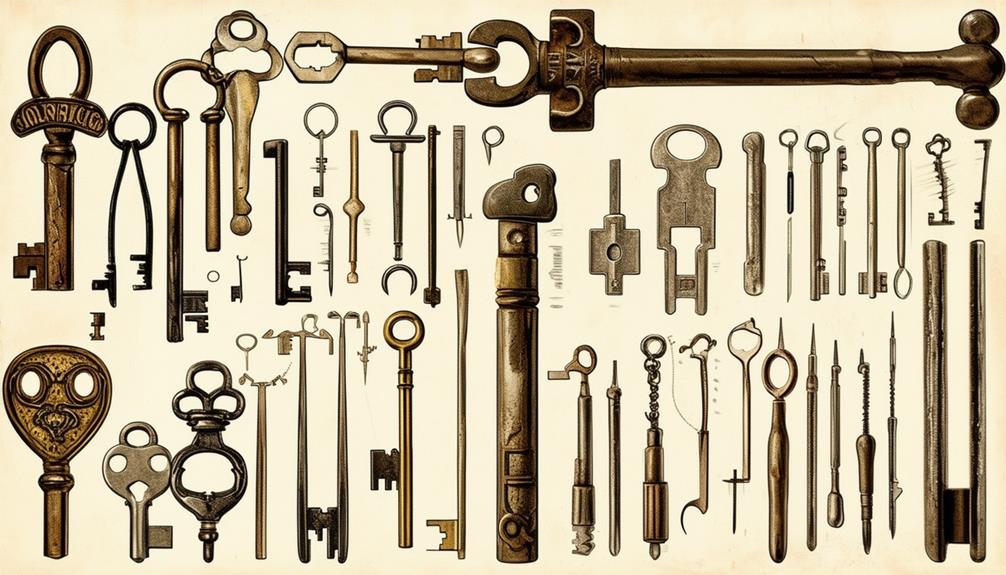
Now let's talk about Medieval Developments in lock picking tools. During the medieval period, locks became more intricate, encouraging the advancement of lock picking tools.
Innovations in keyhole design also emerged, challenging locksmiths to adapt their tools for these new mechanisms. Importantly, locksmiths began to utilize specialized tools such as hook picks and tension wrenches, which were essential for manipulating the complex locking mechanisms of the time.
These advancements reflect the significant role of medieval locksmith tools in enhancing security and the skills required to bypass it. Additionally, locksmith guilds started to regulate the trade, influencing the development and availability of lock picking tools.
Medieval Lock Complexity
During the medieval period, lock complexity saw significant advancements as locksmiths sought to create more secure mechanisms to protect valuable possessions.
Lock designs became more intricate and challenging to pick, requiring locksmiths to develop more sophisticated tools for the task.
- Introduction of Warded Locks: Locksmiths began implementing warded locks, which featured internal obstructions known as wards that only allowed specially shaped keys to turn the mechanism, enhancing security.
- Development of Lever Tumbler Locks: Lever tumbler locks emerged, with levers of varying lengths that needed to be lifted to specific heights by the key to align the slots and allow the bolt to slide, making picking more intricate.
- Incorporation of Multiple Moving Parts: Locks started to incorporate multiple moving parts like springs, levers, and bolts, increasing the complexity of lock mechanisms and making them harder to manipulate without the correct key.
These advancements in lock complexity during the medieval period laid the groundwork for future innovations in lock picking tools.
Keyhole Design Innovations
Keyhole designs in medieval times underwent significant innovations as locksmiths sought to enhance the security and functionality of locks.
One key innovation was the introduction of warding systems within keyholes. These warding systems consisted of obstructions or barriers inside the keyway, requiring specially shaped keys to navigate through them. This design made it more challenging for unauthorized individuals to pick the lock without the correct key.
Locksmiths also experimented with varying key shapes and sizes to improve security. By creating intricate and unique key designs, locksmiths could increase the complexity of the lock, making it harder for potential intruders to bypass the mechanism.
Additionally, some keyholes were designed to be hidden or disguised within the lock, adding an extra layer of security by making it difficult for unauthorized individuals to even locate the keyhole.
Locksmith Guild Regulations
Amidst the evolving landscape of lock technology during medieval times, locksmith guild regulations played a pivotal role in shaping the standards and practices within the industry.
The history of lock picking was greatly influenced by these regulations, which aimed to maintain quality, security, and ethical conduct among locksmiths.
- Quality Standards: Guild regulations enforced strict guidelines on the materials and techniques used in crafting locks and keys, ensuring durability and reliability.
- Security Protocols: Locksmith guilds established protocols to safeguard sensitive information regarding lock mechanisms and key designs, preventing unauthorized access.
- Ethical Practices: Guild regulations emphasized the importance of integrity and professionalism within the locksmithing profession, fostering trust with clients and promoting ethical conduct.
Industrial Revolution Impact
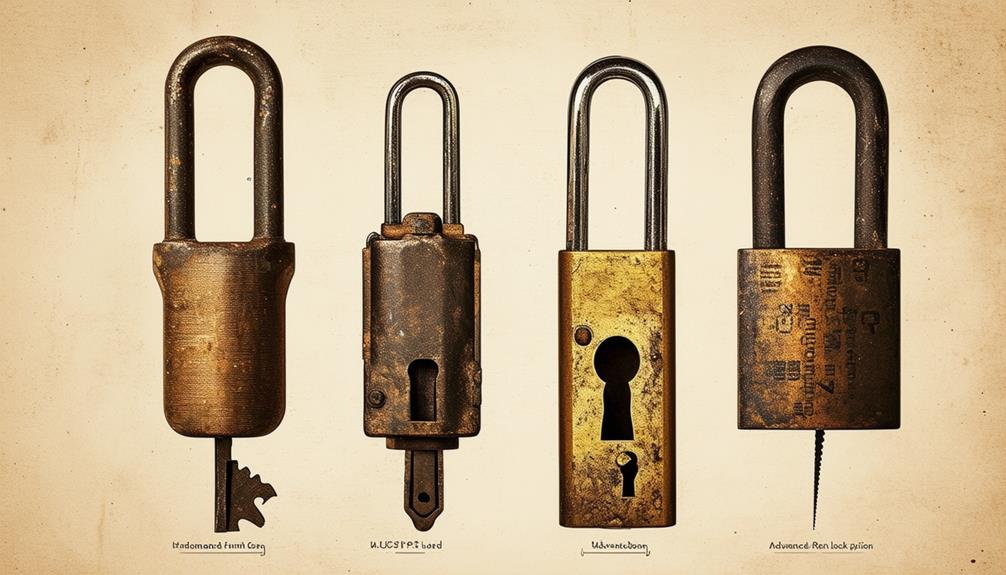
With the advent of the Industrial Revolution, the landscape of lock picking tools underwent a profound transformation. The Industrial Revolution brought about significant advancements in manufacturing techniques, leading to the mass production of modern lockpicking tools. This period saw the introduction of precision machinery, allowing for the creation of more intricate and specialized tools for locksmiths and security professionals.
Additionally, the rise of advanced lock picking techniques during this time further enhanced the skill set of locksmiths, enabling them to tackle increasingly complex locking mechanisms.
One of the key impacts of the Industrial Revolution on lock picking tools was the standardization of designs and the use of durable materials such as steel. This shift towards mass production made modern lockpicking tools more accessible and affordable, enabling locksmiths to work more efficiently and effectively.
Furthermore, the Industrial Revolution spurred innovation in lock designs, prompting locksmiths to develop new tools to keep up with the changing mechanisms. This period marked a turning point in the evolution of lock picking tools, setting the stage for further advancements in the 19th century.
19th Century Advancements
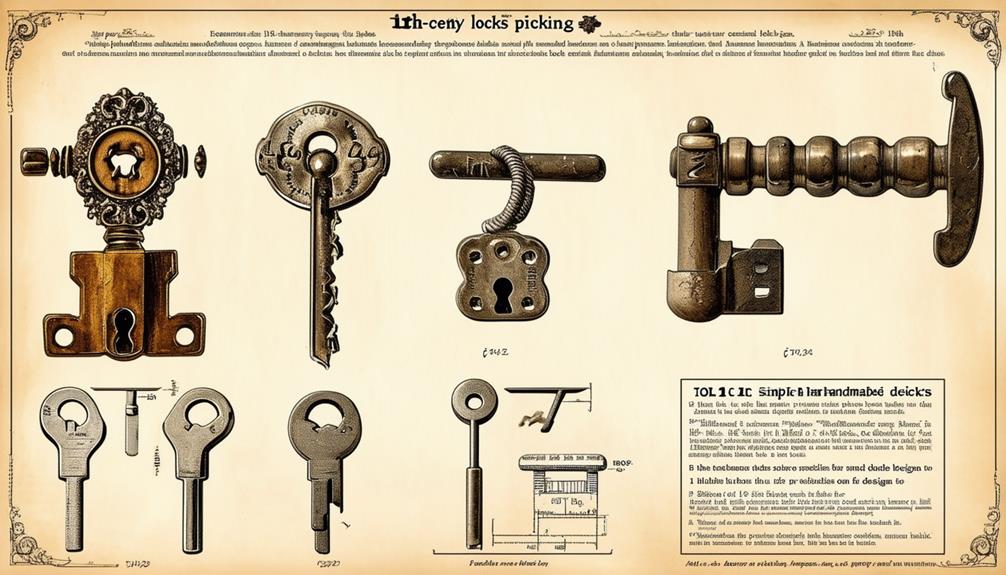
As the 19th century progressed, advancements in lock picking tools continued to shape the field of locksmithing. During this time period, historic lock picking tools underwent significant improvements and innovations that revolutionized the way locks were manipulated.
Understanding the mechanics of different lock types was vital, as it allowed locksmiths to identify specific vulnerabilities and develop more effective tools for their trade, demonstrating the importance of knowledge of lock components.
- Development of Skeleton Keys: Locksmiths in the 19th century refined the design of skeleton keys, making them more versatile and capable of opening a wider range of locks with intricate mechanisms.
- Introduction of Lever Tumblers: The addition of lever tumblers to lock picking tools provided locksmiths with a more precise method of manipulating internal mechanisms, allowing for quicker and more efficient lock picking.
- Invention of the Pick Gun: The creation of the pick gun was a game-changer in the locksmithing industry, offering a faster and more automated approach to picking locks by using a rapid series of impacts to manipulate the pins inside the lock.
These advancements paved the way for modern lock picking techniques and tools that are still used today.
World War Influence
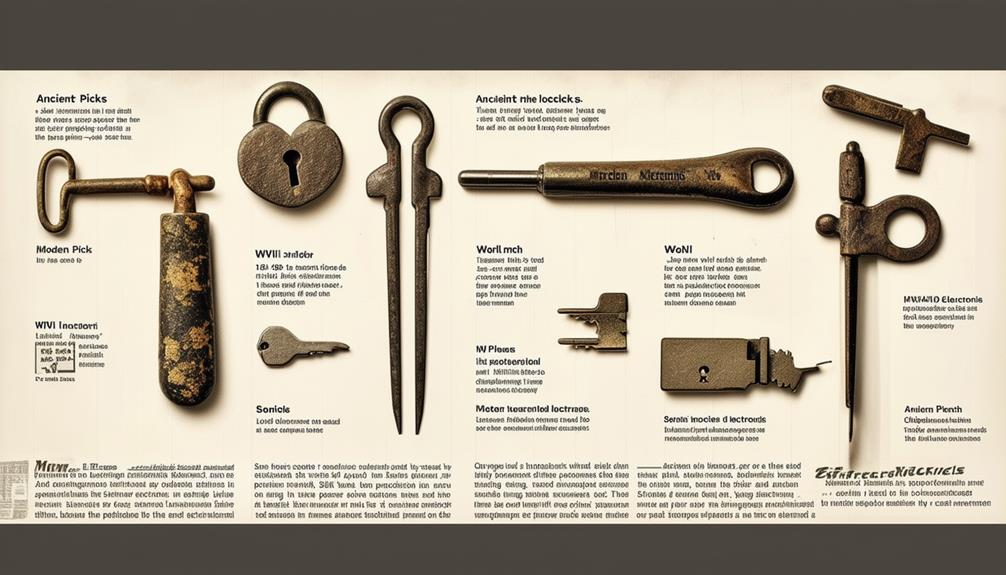
Lock picking tools continued to evolve considerably during the tumultuous period of World War influence. The need for covert operations and intelligence gathering during World War I and World War II led to advancements in lock picking tools. Specialized tools were developed for military personnel and spies to gain access to secure locations quickly and discreetly.
As techniques such as mastering historic lock-picking techniques gained popularity, these tools were designed to be compact, lightweight, and easy to conceal, allowing operatives to bypass locks with precision and speed.
Lock picking tool evolution during this time focused on creating tools that were versatile and effective across various types of locks. The tools became more refined, incorporating new materials and designs that improved their functionality.
Military engineers collaborated with locksmiths to enhance the effectiveness of these tools, resulting in innovative solutions for bypassing locks in high-stakes situations.
The World Wars marked a significant chapter in the evolution of lock picking tools, shaping them into sophisticated instruments used not only for military purposes but also by law enforcement agencies and locksmiths worldwide.
Modern Technology Integration
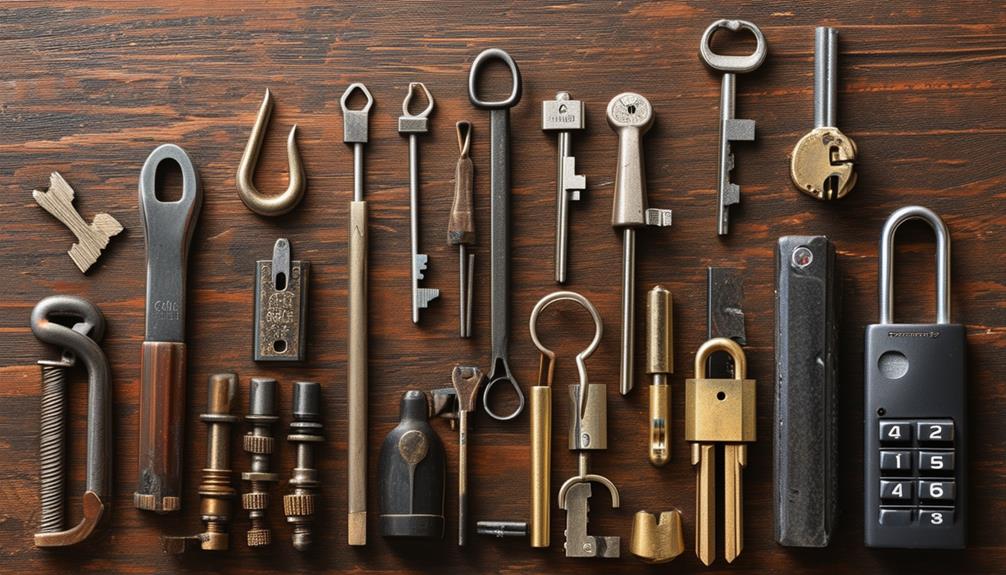
The integration of modern technology has revolutionized the field of lock picking, ushering in a new era of tools and techniques.
Modern locksmithing tools are now more sophisticated and efficient than ever before, allowing locksmiths to work with greater precision and speed. For instance, many experts now rely on essential tools that enhance their lock picking capabilities.
Here are a few ways technology has transformed lock picking:
- Electronic Lock Picks: Advanced electronic lock picks use digital technology to analyze and manipulate lock mechanisms, making it easier to bypass security measures.
- Key Decoders: Key decoding technology enables locksmiths to quickly determine the correct key pattern for a lock, streamlining the process of creating duplicate keys.
- Automated Lock Picking Machines: Automated machines equipped with cutting-edge technology can now be programmed to pick locks with incredible accuracy, reducing the margin of error.
These modern tools not only enhance the capabilities of locksmiths but also contribute to increased security measures to protect against unauthorized access.
As technology continues to advance, the future of lock picking tools holds even more exciting possibilities.
Future Trends in Lock Picking
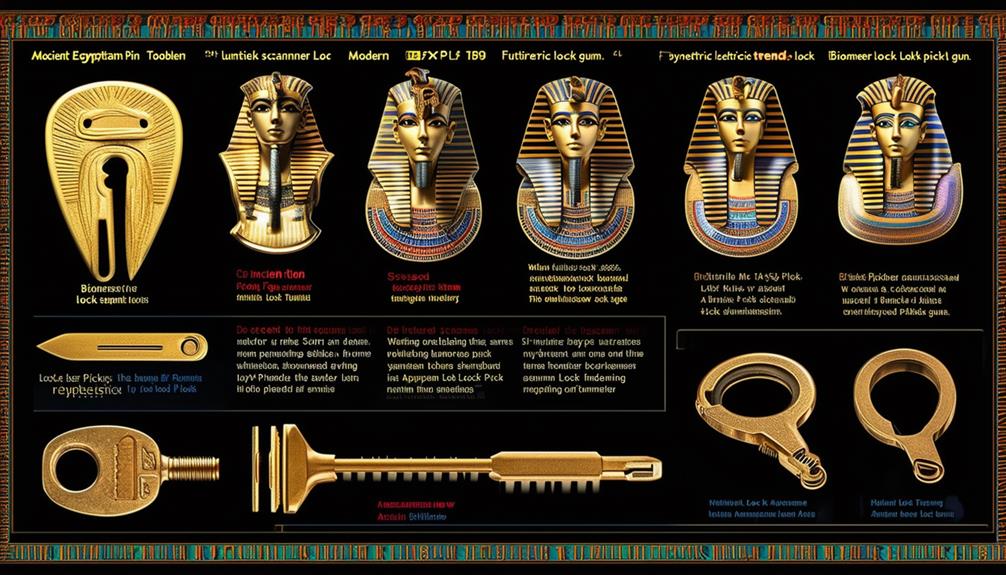
As you look ahead to the future of lock picking, consider the ever-growing role of technology in this field.
With innovations in both lock design and picking tools, competitors are increasingly relying on advanced techniques to stay ahead of security measures.
Advanced security measures are continuously being developed to counteract the evolving techniques of lock pickers.
Understanding these trends will be essential for staying informed and adapting to the changing landscape of security systems.
Technology in Lockpicking
With advancements in technology revolutionizing various industries, the field of lock picking is also experiencing significant changes.
Lock picking tools are becoming more sophisticated and efficient, thanks to technological innovations. Here are some key trends to watch out for:
- Integration of AI: Artificial intelligence is being incorporated into lock picking tools to enhance precision and speed in bypassing security mechanisms.
- Internet of Things (IoT) Connectivity: Lock picking tools are now being designed to connect to IoT networks, allowing for remote access and control, making them more versatile and convenient.
- Biometric Recognition: Advanced lock picking tools are being developed to incorporate biometric recognition technology, such as fingerprint scanning or facial recognition, adding an extra layer of security and making unauthorized access even more challenging.
These advancements in lock picking technology are reshaping the industry, providing locksmiths and security professionals with powerful tools to enhance their capabilities and stay ahead of evolving security systems.
Advanced Security Measures
Amid the continuous evolution of lock picking tools driven by technological advancements, the landscape of security measures is also undergoing a transformation.
With the rise of innovative lockpicking tools, traditional security systems are facing new challenges. Advanced security measures are incorporating biometric authentication, smart locks, and artificial intelligence to enhance protection against unauthorized access.
Biometric authentication utilizes unique physical characteristics such as fingerprints, iris patterns, or facial recognition to verify identity. This technology adds an extra layer of security by making it harder for intruders to bypass conventional locks.
Smart locks, which can be controlled remotely via smartphones or computers, offer convenience and increased monitoring capabilities. However, they also require robust cybersecurity measures to prevent hacking attempts.
Artificial intelligence is revolutionizing security systems by enabling predictive analysis of potential threats and vulnerabilities. By learning from patterns and anomalies, AI can adapt security protocols in real-time to address emerging risks.
As innovative lockpicking tools continue to evolve, the future of security measures lies in staying ahead of potential breaches through adaptive and sophisticated technologies.
Frequently Asked Questions
How Do Lock Picking Tools Work on Different Types of Locks?
Lock picking tools work by manipulating the internal components of a lock to mimic the action of a key.
Different types of locks require various tools like tension wrenches and picks to push the pins or levers into the correct position, allowing the lock to turn and open.
Understanding the mechanics of each lock is essential to skillfully using lock picking tools effectively and gaining access without a key.
Are There Any Famous Historical Figures Known for Lock Picking?
Yes, there are famous historical figures known for lock picking.
Notable individuals like Harry Houdini, the renowned magician, and escape artist, were skilled in the art of lock picking.
Houdini's abilities in escaping from handcuffs, shackles, and locked containers fascinated audiences worldwide.
Through his performances, he showcased the dexterity and precision required for successful lock picking, cementing his legacy as a master of the craft.
What Materials Were Commonly Used to Make Ancient Lock Picking Tools?
Imagine ancient locksmiths crafting tools from sturdy bronze and sharp iron, honing their skills to perfection.
These materials were commonly used to create lock picking instruments in days of old.
With precision and dexterity, these artisans fashioned tools that could open even the most intricate locks of their time.
The ingenuity and craftsmanship of these early locksmiths paved the way for the evolution of lock picking tools throughout history.
Has the Legality of Lock Picking Tools Changed Over Time?
Over time, the legality of lock picking tools has indeed changed.
Laws regarding possession and use of these tools have become stricter in many places to combat potential misuse.
It's essential to stay informed about the current regulations in your area to avoid unintentionally breaking the law.
Always remember to use lock picking tools responsibly and only when legally allowed to do so.
Can Modern Lock Picking Tools Be Used for Illegal Purposes?
Modern lock picking tools can indeed be used for illegal purposes. They offer convenience and speed in gaining unauthorized access, making them appealing to those with malicious intent.
While lock picking itself can be a valuable skill for locksmiths and security professionals, in the wrong hands, these tools pose a significant security threat.
It's essential to use lock picking tools responsibly and guarantee they aren't misused for illegal activities.
Conclusion
You've just scratched the surface of the fascinating world of lock picking tools! From ancient Egyptian innovations to modern technological advancements, the evolution of these tools has been nothing short of mind-blowing. Who knew something as simple as a key could lead to such intricate and complex devices? Keep exploring and who knows, maybe you'll become the next master lock picker of the future!

